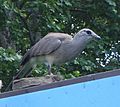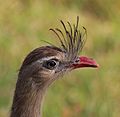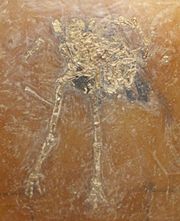Seriema facts for kids
Quick facts for kids Seriemas |
|
|---|---|
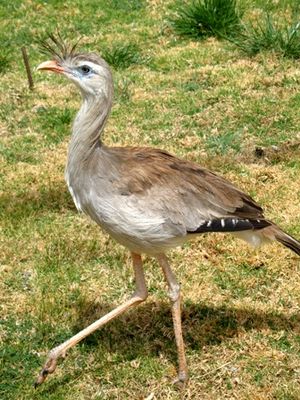 |
|
| Red-legged seriema (Cariama cristata) | |
| Scientific classification |
|
| Kingdom: | Animalia |
| Phylum: | Chordata |
| Class: | Aves |
| Order: | Cariamiformes |
| Superfamily: | Cariamoidea Bonaparte, 1853 |
| Family: | Cariamidae Bonaparte, 1853 |
| Genera | |
|
Cariama |
|
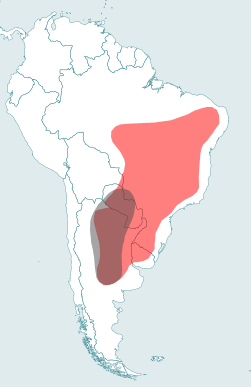 |
|
| Ranges of red-legged (red) and black-legged (black) seriemas | |
Seriemas are unique birds that live in South America. They are the only living members of a bird family called Cariamidae. These birds are known for their long legs and their loud calls.
Scientists once thought seriemas were related to cranes. However, they are now believed to be closer to falcons, parrots, and passerines (songbirds). They are also related to the huge, extinct "terror birds". Seriemas are large, long-legged birds. They can grow to be about 70 to 90 centimeters (27 to 35 inches) long. You can find them in grasslands, savannas, dry woodlands, and open forests. They live in countries like Brazil, Bolivia, Argentina, Paraguay, and Uruguay.
There are two types of seriemas:
- The red-legged seriema (Cariama cristata)
- The black-legged seriema (Chunga burmeisteri)
Their name comes from Tupian languages. Words like siriema or çariama mean "crested," which refers to the feathers on their heads.
Contents
What Do Seriemas Look Like?
Both seriema species are fairly large birds. The red-legged seriema is a bit bigger, reaching about 90 centimeters (35 inches). The black-legged seriema is usually 70 to 85 centimeters (27 to 33 inches) long.
These birds spend most of their time on the ground. They run away from danger instead of flying. Even though they can fly short distances, they prefer to run. They also roost, or rest, in trees at night. Seriemas have long legs, long necks, and long tails. Their wings are quite short, which shows how much they prefer to stay on the ground. They are among the biggest ground-dwelling birds found only in the Neotropics (a region in the Americas). Only rheas are larger.
Seriemas are brownish birds with short beaks. They have a crest of feathers on their heads that they can raise. You can find them in dry, open areas. The red-legged seriema likes grasslands. The black-legged seriema prefers scrublands and open woodlands. They make very loud, yelping calls. Often, you will hear them before you see them. They have sharp claws, and one claw on their second toe is extra long and curved.
-
The black-legged seriema (Chunga burmeisteri) is smaller and lives in a smaller area.
-
The crest on the head of the red-legged seriema (Cariama cristata) is special among birds in the Neotropics.
Seriema Behavior and Diet
Seriemas are a lot like the secretary bird of Africa. They both hunt on the ground. Seriemas eat many different things. Their diet includes insects, snakes, lizards, frogs, young birds, and rodents. They also eat small amounts of plants, like maize (corn) and beans.
You might see seriemas near grazing livestock. They do this to catch insects that the animals stir up. When a seriema catches a small reptile, it will hit the prey on the ground. They might also throw it against a hard surface. This helps to break the prey's bones and make it easier to eat. If the prey is too big to swallow whole, the seriema will tear it into smaller pieces. They hold the prey in their beak and use their special curved claw to rip it apart.
Because of what they eat, seriemas are helpful to the environment. They eat detritivores (animals that eat dead plant matter). This helps to return nutrients to the soil.
When seriemas see humans, they are often cautious. If they feel threatened, they might spread their wings and face the person. They usually walk around in pairs or small groups. Even though they can fly, they prefer to stay on land. They only fly when they need to escape danger. At night, they find shelter in the tops of trees. This is also where they build their nests.
Seriema Reproduction
Not much is known about how seriemas reproduce. Most of what we know comes from studying red-legged seriemas. Breeding pairs seem to protect their territory. They try to keep other seriemas away during breeding season. Fights between rival birds have been seen. These fights can last a long time and involve a lot of loud calls. The birds kick each other during these fights.
Seriemas build a large, messy nest out of sticks. They line the nest with leaves and animal dung. The nest is usually placed in a tree, about 1 to 5 meters (3 to 16 feet) off the ground. They build the nest so that they can reach it by hopping and fluttering, rather than flying directly to it. Both the male and female seriema help build the nest.
They lay two or three eggs. The eggs are white or light brown with a few brown and purple spots. The female bird does most of the incubating, which means sitting on the eggs to keep them warm. This takes about 24 to 30 days. When the chicks hatch, they are covered in soft downy feathers. They stay in the nest for about two weeks. After that, they leave the nest and follow both parents. Young seriemas become fully grown when they are about four to five months old. We do not know when they are old enough to have their own chicks.
Seriema Family Tree
There are two types of seriemas alive today:
- The red-legged seriema (Cariama cristata) lives from eastern Brazil to central Argentina. It is larger and builds nests on the ground or in bushes or trees up to 3 meters (10 feet) high.
- The black-legged seriema (Chunga burmeisteri) lives in northwest Argentina and Paraguay. It builds its nests in trees.
Scientists believe seriemas are the closest living relatives of the "terror birds". These were huge, meat-eating birds that could be up to 3 meters (10 feet) tall. We know about them from fossils found in South and North America. Other related bird groups, like the idiornithids and bathornithids, lived in North America and Europe a long time ago.
The fossil record for seriemas themselves is not very complete. We know of two ancient seriema species: Chunga incerta and Noriegavis santacrucensis. Both of these fossils were found in Argentina and are from the Miocene epoch. Some other ancient bird fossils, like Salimia and Idiornis from the Eocene epoch, might also be seriemas. The large predatory bird Paracrax from the Oligocene of North America has also been suggested to be a seriema relative, but this is still being studied.
See also
 In Spanish: Cariámidos para niños
In Spanish: Cariámidos para niños


